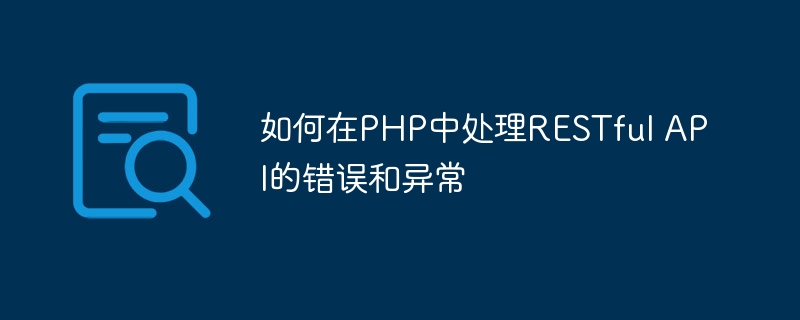

How to handle RESTful API errors and exceptions in PHP
When developing a RESTful API, handling errors and exceptions is crucial. Good error and exception handling not only improves the maintainability of your code, but also provides a better experience for users. This article will introduce how to handle RESTful API errors and exceptions in PHP and provide relevant code examples.
First, let’s understand the errors and exceptions that may occur in RESTful APIs. Common errors include: invalid request parameters, unauthorized access, non-existent resources, etc. During the process of processing requests, various exceptions may occur, such as database connection failure, file read and write errors, etc. In actual development, we need to handle different errors and exceptions accordingly.
A common error handling strategy is to use HTTP status codes to indicate error types and return error information to the client as a response body. The following is a sample code for handling invalid request parameter errors:
function handleInvalidParameterError() {
header('HTTP/1.1 400 Bad Request');
$error = array('message' => 'Invalid parameter');
echo json_encode($error);
}
$param1 = $_GET['param1'];
$param2 = $_GET['param2'];
if (!isset($param1) || !isset($param2)) {
handleInvalidParameterError();
exit;
}
// 继续处理请求
// ...Here, it is determined whether the request parameters are valid by checking whether the GET parameters exist. If the parameter does not exist, call the handleInvalidParameterError() function to return an error response.
In addition to returning error information, we can also track errors through logging. You can use PHP's built-in logging function to write error information to a log file. The following is a sample code that records a database connection failure exception:
function handleDatabaseConnectionException($e) {
error_log('Database connection failed: ' . $e->getMessage());
header('HTTP/1.1 500 Internal Server Error');
$error = array('message' => 'Internal Server Error');
echo json_encode($error);
}
try {
// 连接数据库
// ...
} catch (Exception $e) {
handleDatabaseConnectionException($e);
exit;
}
// 继续处理请求
// ...In the above example, we use the try-catch statement to capture the exception of a database connection failure and call the handleDatabaseConnectionException() function for processing. This function writes error information to the log file and returns a 500 Internal Server Error response.
In addition to the above common errors and exceptions, there are some special situations that require additional handling. For example, when the resource requested by the user does not exist, we can return a 404 Not Found response. The following is a sample code for handling resource non-existence errors:
function handleResourceNotFoundError() {
header('HTTP/1.1 404 Not Found');
$error = array('message' => 'Resource not found');
echo json_encode($error);
}
// 判断资源是否存在
if (!$resourceExists) {
handleResourceNotFoundError();
exit;
}
// 继续处理请求
// ...Here, the $resourceExists variable is used to determine whether the resource exists. If the resource does not exist, the handleResourceNotFoundError() function is called to return a 404 Not Found response.
In addition to the error and exception handling strategies in the above examples, we can also flexibly handle them according to specific business needs. For example, you can return different HTTP status codes based on different error types, or append more detailed information to the error message.
To summarize, good error and exception handling can improve the stability and usability of RESTful APIs. In PHP, we can use HTTP status codes and JSON-formatted response bodies to represent errors and exceptions, and combine them with logging to help troubleshoot problems. I hope the introduction and examples in this article can help you better handle errors and exceptions in RESTful APIs.
The above is the detailed content of How to handle errors and exceptions of RESTful API in PHP. For more information, please follow other related articles on the PHP Chinese website!